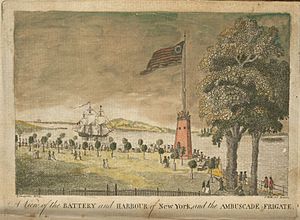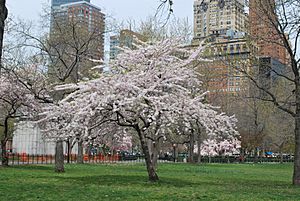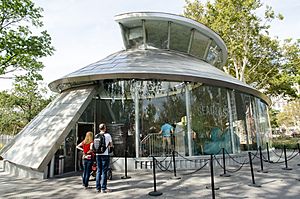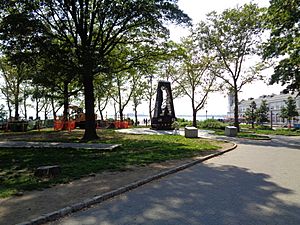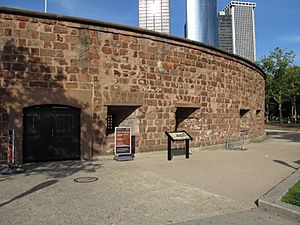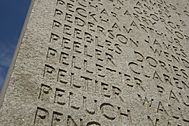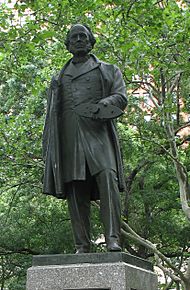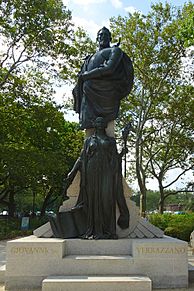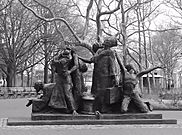The Battery (Manhattan) facts for kids
Quick facts for kids The Battery |
|
|---|---|
| Battery Park | |
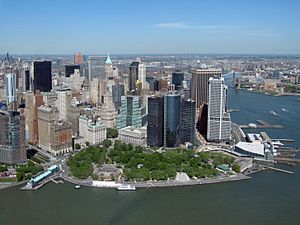
Aerial view of the Battery in 2010. At park's left is Pier A, at park's right is South Ferry Terminal. On the far right is the East River.
|
|
| Location | Southern tip of Manhattan Island in New York City; bounded by New York Harbor to the south |
| Area | 25 acres (10 ha) |
| Created | 1823 |
| Etymology | Artillery battery |
| Owned by | New York City Department of Parks and Recreation |
| Operated by | The Battery Conservancy |
| Open | 6 a.m. to 1 a.m. |
| Public transit access | Bus: M5, M15 SBS, M20 Subway: |
| Website | NYC Parks The Battery Conservancy |
The Battery, once known as Battery Park, is a large 25-acre (10 ha) public park. You can find it at the very southern tip of Manhattan Island in New York City. It looks out over New York Harbor. The park is bordered by Battery Place to the north, State Street to the east, New York Harbor to the south, and the Hudson River to the west.
Inside the park, you'll discover cool places like an old fort called Castle Clinton. There are also many monuments and the fun SeaGlass Carousel. The area around the park, known as South Ferry, has several ferry terminals. These include the Staten Island Ferry's Whitehall Terminal. You can also catch boats here to the Statue of Liberty National Monument (which includes Ellis Island and Liberty Island) and Governors Island.
The park and its surroundings got their name from the "artillery batteries." These were groups of cannons built in the late 1600s to protect the settlement behind them. By the 1820s, the Battery became a popular spot for entertainment. Castle Clinton, the old fort, was even turned into a theater. In the mid-1800s, the park we see today was built. Castle Clinton then became a center for immigrants and customs. Many immigrants arriving in New York City landed at the Battery until 1890. That's when the immigration center moved to Ellis Island. After that, Castle Clinton housed the New York Aquarium from 1896 to 1941.
In 1940, Battery Park closed for twelve years. This was because of the construction of the Brooklyn–Battery Tunnel and the Battery Park Underpass. The park reopened in 1952 after being fixed up. However, it later started to decline. In 1994, a group called The Battery Conservancy was started by Warrie Price. This group helped pay for and manage the park's restoration. In 2015, the Conservancy changed the park's name back to its original, historic name: "The Battery."
History of The Battery
Early Days and Forts
The land where The Battery now stands was first home to the Lenape Native Americans. In the early 1600s, Dutch settlers arrived and built the settlement of New Amsterdam. They called the southern tip of Manhattan "Capske Hook," which came from a Lenape word meaning "rocky ledge." This area was a narrow, hilly strip of land.
In 1625–1626, the Dutch built Fort Amsterdam on a hill where the Alexander Hamilton U.S. Custom House is today. This fort was not very effective. In 1664, the British took control and renamed the defenses Fort James. In 1683, cannons were placed at the fort, creating an "artillery battery." This is how the Battery got its name! The fort was renamed several times, finally becoming "Fort George" by 1714.
The Battery's cannons were not fired again until 1776 during the American Revolutionary War. American troops took over the fort but could not stop the British from sailing up the Hudson River. After the British landed at Kip's Bay on September 15, 1776, the Americans left the fort. The British then took control of Lower Manhattan.
At the end of the war in 1783, the Battery was the center of Evacuation Day parties. This day celebrated the last British troops leaving the United States. A flagpole was later put up to remember this event. By 1788, Fort George was torn down. The leftover materials were used to make the Battery area larger. The fort's site became Government House, a fancy home meant for U.S. president George Washington. However, he never actually lived there.
From 1808 to 1811, before the War of 1812, the West Battery was built on a small artificial island nearby. This fort was meant to replace the older ones. The West Battery was never used in battle. After the war, it was renamed Castle Clinton. When Battery Park was later expanded with new land, it surrounded and included this island. About 3 acres (1.2 ha) were added to the park in 1824. Castle Clinton was then given to the city government, which turned it into an entertainment spot. It later served as an immigration and customs center, and even an aquarium.
Building the Park

By the 1840s, important people in the city wanted a new, big park in Manhattan. They said a park would help people stay healthy, improve behavior, and show off the city's elegance. At that time, Manhattan had seventeen squares, totaling 165 acres (67 ha). The largest was the 10-acre (4.0 ha) park at the Battery.
People suggested two places for a large park: Jones's Wood or the current site of Central Park. Another idea was to make the existing Battery Park bigger. Most people liked this idea. However, wealthy merchants did not want Battery Park expanded. They thought it would be dangerous for ships. As a compromise, New York City's leaders voted to expand Battery Park to 24 acres (9.7 ha). In the end, the plans for a huge park led to the creation of Central Park.
The modern Battery Park was mostly created by adding new land, called "landfill," starting in 1855. This landfill used dirt from street-widening projects in Lower Manhattan. This connected Castle Garden's island to the "mainland" of Manhattan. The original shoreline is now roughly the park's eastern edge at State Street. On State Street, the old harbor front and the park's northern border, one old mansion, the James Watson House, still stands. It is now part of the Shrine of Saint Elizabeth Ann Seton.
By 1870, Battery Park and Bowling Green were looking worn out from too much use. There were plans to improve them. Paths were to be built through both parks, meeting at a plaza outside Castle Clinton. City Pier A, just north of Castle Clinton, was ordered in 1886 and finished two years later. This building first held the New York City Board of Dock Commissioners. Later, it was used as a fireboat station until 1992.
Elevated and Subway Trains
Several elevated train lines, or "els," were built to Battery Park in the late 1800s. But they caused problems. The els used steam trains until 1902, which created a lot of pollution in Battery Park. The New York Elevated Railroad Company opened the Battery Place elevated station at the park's northern end in 1872. Then, the two-track South Ferry elevated station opened at the park's southern end in 1877. The railroad company agreed to make Battery Park look nicer if they could build the station. However, many people soon wanted the elevated tracks removed.
A bigger four-track station was built nearby in 1879. It served the Second, Third, Sixth, and Ninth Avenue Lines. In 1883, the state government looked into how the elevated station was allowed to be built. The next year, New York Elevated wanted to make the Battery Place station platforms longer over Battery Park. Other plans to build elevated tracks over Battery Park were suggested in 1889 and 1891 but were not approved.
By 1900, the els were seen as a bother. People wanted to remove the elevated tracks that ran directly over the park. This did not happen for another fifty years. In 1903, a state assemblyman tried to pass a bill that would give the elevated train companies the only right to build a train terminal at Battery Park. This would stop the Interborough Rapid Transit Company (IRT) from building its underground subway. The bill did not pass. By then, the IRT Lexington Avenue Line, the Joralemon Street Tunnel to Brooklyn, and the South Ferry subway terminal were being built right under the park. The South Ferry station opened in 1905, and the Joralemon Street Tunnel opened in 1908.
Another early way to travel was by streetcars. These stopped at Battery Place and went up both sides of Manhattan Island. These streetcar lines ended at South Ferry. They included routes that are now the M7, M20, M55, M103 bus routes. The streetcars were removed by 1936, though only some were replaced by buses.
The 20th Century and Changes
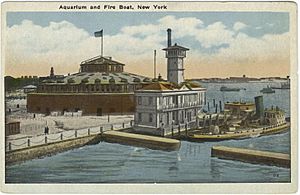
By the 1900s, Battery Park started to look run down. Many new buildings were suggested for the park. Most of these plans were not built because people did not want them. For example, in 1901, a large arch to honor United States Navy soldiers was proposed. Another monument, for steamboat operator Robert Fulton, was suggested in 1905. There was also a plan to build a playground in the park, but it was stopped in 1903. People were so against new buildings in Battery Park that even the IRT subway construction under the park was opposed.
Other ideas included a 1910 plan to make the Aquarium bigger and a proposal for a jogging field the next year. During World War I, there was a plan to build a government building there. This plan was dropped after the U.S. government found a new location.
Ideas to redesign Battery Park continued. An expansion of the New York Aquarium was announced in 1921. A new memorial plaque was also revealed that year. By 1926, a group called the Battery Park Association formed to find ways to improve the park. In 1928, it was suggested to remove the elevated trains from Battery Park. The next year, a memorial for immigrants was proposed. The park itself was suggested to be rebuilt into a grand formal view.
In 1940, Battery Park was partly closed for the building of the Brooklyn–Battery Tunnel. The aquarium also closed. Many plans to change Battery Park were then suggested. A design contest to rebuild Battery Park was held in 1941. A plan to replace Castle Clinton with a Fort Clinton memorial was also discussed. While the park was closed, its northern end was used to store construction waste. A second tunnel, the Battery Park Underpass, began construction in 1949.
The Brooklyn-Battery Tunnel opened the next year. The South Ferry elevated station was removed after the last elevated line closed. After the underpass was finished in 1951, the park was relandscaped and made 2 acres (0.81 ha) larger. It reopened in 1952. In its new design, Battery Park had a landscaped esplanade, a raised waterfront terrace, and an oval lawn with a playground. Various statues, which were once spread out, were rearranged. The park's reconstruction cost about $2.38 million.
Several memorials opened in the mid-1900s. Peter Minuit Plaza and a Coast Guard memorial were both dedicated in 1955. The East Coast Memorial was dedicated in 1963. Also, a 2,500-foot-tall (760 m) "space needle" with offices was proposed for the Battery in the 1960s. This was twice the height of the Empire State Building. It would have been built partly on new land next to the Battery. The "needle" was never built. The extra earth from the construction of the World Trade Center was used to create Battery Park City, just north of Battery Park.
By 1971, Battery Park was so run down that a U.S. representative called it "a national disgrace." He suggested hiring two National Park Service employees to clean it up. Castle Clinton was fixed up several years later and reopened in 1975.
In 1982, Battery Park and other "historic waterfront sites" were named part of a "Harbor Park" zone by New York State. These sites included South Street Seaport in Manhattan, Liberty and Ellis Islands, Fulton Ferry in Brooklyn, and Sailors' Snug Harbor in Staten Island. New ferry routes were planned to connect them. This "Harbor Park" was meant to create a bigger tourist area focused on New York Harbor's history. The "park" opened in July 1984.
Restoration and the 21st Century
Battery Park City, a planned waterfront neighborhood, was built in the 1970s and 1980s. Its success brought attention and new money for Battery Park projects. For example, $5 million was given for a garden near Castle Clinton. In 1988, governor Mario Cuomo and mayor Ed Koch announced a $100 million plan. This plan was to build two new parks in Battery Park City and redesign the park at the Battery. This was part of a new Hudson River waterfront park system.
However, by the 1990s, Battery Park was worn out. Many nearby residents and tourists avoided it, except when taking boats to the Statue of Liberty and Ellis Island. The New York Times described the park as having "broken benches," "dirt and litter," and "unreadable graffiti." The nonprofit Battery Conservancy was created in 1994. One of its first actions was to create a plan for the park and renovate it for $30 million. In 1998, Mayor Rudy Giuliani's government announced a $40 million plan to renovate Battery Park. This project, like successful ones at Bryant and Central Parks, involved moving the Battery's 23 statues and expanding Castle Clinton. Most of the money was to come from private donations.
One of the first renovation projects was fixing the park's seawall and promenade for $5.5 million. Even though Battery Park was used as an emergency area after the September 11 attacks in 2001, construction on the upper promenade continued. It opened in December 2001. The Battery Bosque, a new landscaped garden, opened in 2005.
Some restoration projects happened in Battery Park in the 2010s. These included adding a community garden, renovating a promenade, and building the SeaGlass Carousel. By June 2012, a third of the park was closed off for these projects. But the park stayed open, serving 10,000 to 15,000 visitors daily. In October of that year, Hurricane Sandy caused severe damage to the area. The park was underwater for several hours. The Battery Conservancy restored the wooded areas and added gardens to help with future storms. The SeaGlass Carousel was mostly fine after Hurricane Sandy, but its opening was delayed until August 2015.
The New York City Department of Parks and Recreation brought back the park's original name, "The Battery," in 2015. By 2016, the Battery Conservancy had raised $46 million in private money and $92 million from the city. They planned to use these funds for more park improvements. For example, the Battery Oval opened in 2016. A 1.4-acre (0.57 ha) eco-friendly, flood-resistant playground called the Playscape was proposed in 2016. Work began in March 2020, and it is expected to open in early 2021.
Fun Things to See
The Battery has many attractions and interesting spots. Castle Clinton, an old fort, is near the park's northwestern corner. It is the main attraction. North of it is the old fireboat station, Pier A, which became a restaurant in 2014. Another restaurant, Battery Gardens, is next to the United States Coast Guard Battery Building.
Nearby is the 4-acre (1.6 ha) Battery Bosque garden. It was designed by Dutch landscape architect Piet Oudolf and has 140 plane trees. Another group of 15 trees was given to the park in 1976 by the city of Jerusalem. This area, northwest of Castle Clinton, is called Jerusalem Grove. The northeastern corner has a lawn called the Battery Oval. This 90,000-square-foot (8,400 m2) lawn opened in 2016 as part of a big park restoration. It has turf made of Kentucky bluegrass. Along the waterfront, Statue Cruises offers ferries to the Statue of Liberty and Ellis Island.
The southwestern corner of the Battery has the SeaGlass Carousel. This attraction has bioluminescent (glowing) designs. It honors the carousel's waterfront location and Castle Clinton's past as an aquarium. The southeastern corner has Peter Minuit Plaza, a place where different types of transportation meet. The plaza has a bus terminal for the M5, M15 SBS, M20 buses. It also has an entrance to the Staten Island Ferry's Whitehall Terminal, entrances to the New York City Subway's South Ferry/Whitehall Street station, and taxi stands. The plaza also includes the New Amsterdam Plein and Pavilion, a pavilion given by the Kingdom of the Netherlands. It shows art, design, and plants.
The park is also home to many memorials and monuments. In 2010, the park had over five million visitors each year. In 2016, the Battery Conservancy said the park had 600,000 visitors a month, which is about 7.2 million visitors per year.
Castle Clinton: A Historic Fort
Castle Clinton was first called the West Battery. It was built as a fort just before the War of 1812. In 1815, after the war, it was renamed Castle Clinton to honor Mayor DeWitt Clinton. It became city property in 1823. When the city leased it, it became a popular walking area and beer garden called Castle Garden. Later, a roof was added, and it became one of the best theaters in the United States. It helped New York City become a theater capital. In the early 1850s, famous performers like Swedish soprano Jenny Lind and European dancer Lola Montez performed there.
As the city's wealthy people moved uptown, Castle Garden closed in 1855. It was then turned into the world's first immigration center. This center operated until 1890, just before the immigration facility at Ellis Island opened. About 7.7 million immigrants passed through Castle Garden during its time. The building then housed the New York Aquarium from 1896 to 1941. It closed as part of Robert Moses's plans to build the Brooklyn-Battery Tunnel. Moses wanted to create a Fort Clinton memorial there. But he would only keep Castle Clinton if the federal government paid for its restoration. In the end, Castle Clinton was saved as a National Monument in 1946.
The structure was restored in 1975. Today, Castle Clinton keeps its original name and is managed by the National Park Service. It has a small history exhibit and ticket booths for ferries to the Statue of Liberty and Ellis Island. It also sometimes hosts concerts. As the ferry ticket office, it had nearly 4.08 million visitors in 2009. The Statue of Liberty National Monument, which includes Castle Clinton, was the most popular national monument in the U.S. that year.
Park Memorials
Battery Park has over 20 monuments. Many of them are grouped together in an area called "Monument Walk."
The Sphere, Hope Garden, and Flagpole
Five months after being damaged in the September 11 attacks, Fritz Koenig's The Sphere was put back in the northern part of the park. It used to stand in the plaza of the World Trade Center a few blocks away. It was near the Netherlands memorial flagpole in the park's northeast corner. Later, in late 2017, it was moved to Liberty Park in the new World Trade Center.
The Sphere, which is 25 feet (7.6 m) tall, was meant to represent world peace through trade. At its original spot, it was in the center of fountains, like the Great Mosque of Mecca. After 2001, it also became a World Trade Center memorial. A plaque next to The Sphere says:
For three decades, this sculpture stood in the plaza of the World Trade Center. Entitled The Sphere, it was conceived by artist Fritz Koenig as a symbol of world peace. It was damaged during the tragic events of September 11, 2001, but endures as an icon of hope and the indestructible spirit of this country. The Sphere was placed here on March 11, 2002, as a temporary memorial to all who lost their lives in the terrorist attacks at the World Trade Center.
This eternal flame was ignited on September 11, 2002, in honor of all those who were lost. Their spirit and sacrifice will never be forgotten.
Inside the park is Hope Garden, a memorial for AIDS victims. The Sphere was sometimes shown here. The garden has also been used for environmental protests because it is a popular tourist attraction.
The Netherlands flagpole was dedicated on December 6, 1926. It was a gift from the Dutch to celebrate 300 years since New Amsterdam was founded. It was first south of Castle Clinton. But during the 1940–1952 renovation, the flagpole was moved to the northeast entrance of the Battery, where it is now. It was fixed up and rededicated in 2000.
East Coast Memorial
The East Coast Memorial is a war memorial from World War II. It is one of three war memorials in the United States managed by the American Battle Monuments Commission. The memorial honors U.S. service members who died in the western Atlantic Ocean during the Battle of the Atlantic. A total of 4,609 names are carved on both sides of eight 19-foot-tall granite pillars. The pillars are in two rows of four. Between the rows is a bronze statue of an eagle on a black granite base. The eagle faces the Statue of Liberty in New York Harbor.
The memorial was designed by Gehron & Seltzer, an architecture firm. The eagle statue was made by Albino Manca, an Italian sculptor. The granite slabs were put up in October 1959. The sculpture was installed in February 1963. President John F. Kennedy dedicated the memorial that May.
American Merchant Mariners' Memorial
The American Merchant Mariners' Memorial sculpture is located in the Hudson River west of the park. It sits on a stone wall just south of Pier A and is connected to the pier by a dock. Sculptor Marisol Escobar designed it, and it was dedicated in 1991. The bronze sculpture shows four merchant seamen with their sinking ship. This happened after it was attacked by German submarine U-123 during World War II. One of the seamen is in the water and is covered by the sea with each high tide. The sculpture is based on a real photo taken by the U-boat's commander. It shows crewmen of the SS Muskogee, all of whom died at sea. The memorial was ordered by the American Merchant Mariners' Memorial, Inc.
Other Memorials to See
The park also has several other memorials, including:
- The Immigrants (1983, rededicated 2005) – This statue by Luis Sanguino is south of Castle Clinton. It shows different types of immigrants who would have passed through Castle Clinton in the late 1800s.
- Korean War Memorial (1991) – This black granite monument is at Battery Place, northeast of Castle Clinton. Designed by Mac Adams, it honors veterans of the Korean War. It was one of the first Korean War memorials in the United States.
- John Ericsson statue (1903) – This statue is near the park's center. Designed by Jonathan Scott Hartley, it honors Ericsson, who designed ironclad warships. It shows him holding a model of the USS Monitor.
- Walloon Settlers Memorial (1924) – Located at Battery Place, this monument was designed by Henry Bacon. It is a stone slab honoring Jessé de Forest for his part in founding New York City.
- Giovanni da Verrazzano (1909) – At Battery Place, this statue by Ettore Ximenes shows Verrazzano, the first European to sail into New York Harbor.
- World War II Coast Guard Memorial (1955) – At the far southeast end of Battery Park, this memorial by Norman M. Thomas shows three figures on a base.
- Wireless Operators Memorial (1915, rededicated 1952) – Near the park's center, this monument is a cenotaph (empty tomb) honoring wireless telegraph operators who died when their ships sank.
Temporary monuments have also been placed in the Battery. These include the Staten Island Ferry Disaster Memorial Museum (2016), which pretended to be about an octopus attack on the Staten Island Ferry. There was also a "UFO Tugboat Abduction Memorial" by the same sculptor.
At least ten monuments, including the Verrazzano, Coast Guard, and Wireless memorials, were stored behind a temporary fence in the park from the mid-2000s until 2016. People worried about the statues' condition in 2015 because renovations took longer than expected. Experts said there should be no long-term damage. The monuments have since been put back in or around the park, though not always in their old spots. Before this $875,000 restoration, some monuments had not been fixed for 60 years.
Around and Under the Park
The Park's Surroundings
To the northwest of the park is Battery Park City. This is a planned community built on new land in the 1970s and 1980s. It includes Robert F. Wagner Park and the Battery Park City Promenade. Battery Park City was named after the park in 1966.
Battery Park has the Battery Bikeway, which is part of the Manhattan Waterfront Greenway. This is a system of parks, bikeways, and promenades around Manhattan Island. The bike path was finished in late 2015. It has terracotta paving near the waterfront, next to a 20-foot (6.1 m) walking path. The bikeway connects to other parts of the Manhattan Waterfront Greenway:
- A bike path starts on the north side of the Battery and runs next to the West Side Highway to its west. North of Battery Park City, the bikeway continues into Hudson River Park, which goes up the Hudson River shoreline.
- Another bike path leaves the Battery from the northwest and runs directly along the Hudson River shore through Battery Park City.
- At the Battery's southeast end, the bikeway continues as the East River Greenway, which runs next to FDR Drive.
Across State Street to the northeast is Bowling Green. You'll also find the old U.S. Customs House there. It is now a branch of the National Museum of the American Indian and a U.S. Bankruptcy Court. Peter Minuit Plaza is next to the park's southeast end, right in front of the Staten Island Ferry's Whitehall Terminal at South Ferry.
Underneath the Park
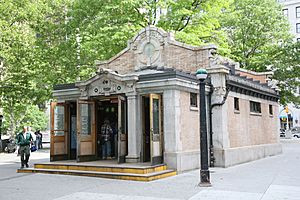
Two road tunnels and several train tunnels run under Battery Park. The Brooklyn–Battery Tunnel, opened in 1950, carries cars to Brooklyn. The Battery Park Underpass, opened in 1951, carries cars from the West Side Highway to the FDR Drive.
Several New York City Subway tunnels also run under the Battery. The old South Ferry station, opened in 1905, was part of the city's first subway line. The former Interborough Rapid Transit Company's Broadway–Seventh Avenue and Lexington Avenue Lines used a balloon loop here. This allowed trains to turn around and switch between the two lines. It closed in 2009 when a new subway station opened.
The new station, South Ferry on the Broadway–Seventh Avenue Line (1 train), opened in 2009. It created a new free connection with the BMT Broadway Line's Whitehall Street station (N, R, and W train). Together, they form the South Ferry/Whitehall Street station complex. The new station was badly damaged by Hurricane Sandy in October 2012. The old loop station was temporarily reopened from April 2013 to June 2017, when the new station reopened.
The Bowling Green station, which opened in 1905 as part of the original subway, serves the 4 and 5 train at the park's northeast corner. Its original entrance, or "Control House", is a New York City landmark. Tracks going south from the station lead to both the old South Ferry station and the Joralemon Street Tunnel. This tunnel goes under the park before traveling under the East River.
Discovery of an Old Wall
In late 2005, New York City officials announced that builders working on the new South Ferry station had found a 45-foot-long (14 m) piece of a stone wall. It was at least from the 1700s. After studying it, experts said the wall was likely the oldest man-made structure still in place in Manhattan. Four walls and over 250,000 individual artifacts were found. A part of one wall was temporarily shown inside Castle Clinton. Another long piece of the wall was permanently placed in the entrance to the new subway station. It is at the same depth below street level as it was found.
Robert Tierney, chairman of the New York City Landmarks Preservation Commission, said the wall was probably built to protect the park's original cannons. The remains were called "an important remnant of the history of New York City."
|
See also
 In Spanish: The Battery (Manhattan) para niños
In Spanish: The Battery (Manhattan) para niños


